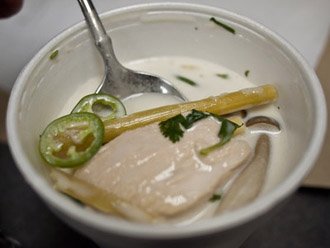Health benefits of Galangal root
-
Galangal root is a low-calorie herb that has been in use in traditional medicines since ancient times to treat indigestion, cold, and ringworm infections (fungal dermatitis).
-
The rhizome composes several flavones like galangin which gives pungent punch to this root. Some of the other chemicals found are alpinin, kampferide, and 3-dioxy-4-methoxy flavone. Together, these compounds contribute antimicrobial, anti-inflammatory, anti-fungal, anti-tumor, and gastroprotective properties to galangal herb.
-
The essential oils such as cineole, methyl cinnamate, myrecene, and methyl eugneol are found quite sufficient amounts in the herb.
-
In the TCM (Traditional Chinese Medicine), it is regarded as having ying actions on the human body, and used to dispel cold illness, and epigastric pain.
-
It composes many essential nutrients and vitamins such as pyridoxine, riboflavin, vitamin C, and pantothenic acid that are required for optimum health.
-
The rhizome also composes a good amount of minerals like iron, potassium, manganese, copper, selenium, and magnesium. Together, these constituents work to keep skin, and hair healthy.
Medicinal uses
-
In Ayurvedic medicine, galangal extraction is used to relieve common cold, acid-peptic symptoms, cough, and sore throat.
-
The overnight soaked liquid infusion of galanga is used to apply over dermatophyte (T. corporis) fungus infection.
-
Its extraction is used for nerve weakness and nervous diseases as it stimulates and strengthens the nervous system.
-
Its infusion is also used to clean bad breath (halitosis), stimulate appetite, and reduce ulcer pain.
-
Regular consumption of galangal tea improves heart health, cardiac output, and blood supply to vital organs.
-
Its ying (warming) effects can help reduce the sputum (Kapha) and reduce asthma episodes the during winter season.
-
The rhizome has also been purportedly used as an aphrodisiac in Arabian traditional medicines. However, no scientific studies back its claim in the treatment of sexual dysfunctions.
Selection and storage
Like ginger, galangal also can be grown in the backyards so that its fresh roots can be readily picked up for immediate use. Fresh galanga is widely available around the year in many South-East Asian regions. In the European and US markets, one may find fresh rhizomes in specialty stores selling Asian spices and herbs. Its dried powder (Laos) is also readily available here.
Buy fresh, light-yellow, healthy-looking roots about the size of a thumb. Fresh roots send a pleasant ginger-like aroma when you hold them close to the nostrils.
Fresh roots should be firm, juicy, and have a light-yellow peel.
Avoid broken, moist, slimy-surface, insect-afflicted roots. Also, avoid oversized, mature, fibrous, woody, shriveled roots as they tend to be less juicy and out of their prime.
Fresh galanga will keep for up to 2 weeks if stored in a cool, dry place. It can be stored in the refrigerator, but it must be wrapped in baking parchment to keep it moist.
Preparation and Culinary use
Wash the root in cold water, and mop-dry using a soft cloth. Peel the skin using a fine peeler. Galangal is quite tough than ginger, and therefore, it is usually thinly sliced (julienned) or cut into matchsticks for cooking. Because it is harder than ginger, it should be cooked for somewhat longer than ginger.
Galanga is an essential flavoring agent in Cantonese and Southeast Asian cooking, particularly in seafood and meat dishes. It is often pounded with shallots, lemongrass, garlic and chilies to make a spicy paste for dips and sauces/curries.
 |
| Tom ka gai (coconut milk-galangal soup). Photo courtesy: Edse Little. |
-
Galangal is used as a substitute for ginger in many traditional dishes in South-East Asian and Cantonese regions.
-
In Thailand, slices of galangal are added to soups. Tom kha gai (ต้มข่าไก่) is a relishing coconut milk soup with shreds of lemongrass and kaffir-lime leaves.
-
Vietnamese cooks add it to a peanut sauce used to dress meat and vegetable salads.
-
The root is also known as laos root in Indonesia, the spice features in tempeh, vegetarian, chicken, and seafood recipes.
-
Galangal tea is a soothing drink in many Asian countries.
Safety profile
Galangal is considered to have warming properties and is used to dispel yin (cold) symptoms. Its use in pregnancy is, therefore, limited. The essential oils in the rhizome often cause dermatitis in sensitive people.
(Medical disclaimer).
You may also like to read ≻≻-
≻≻-Ginger root nutrition facts and health benefits
.
≻≻-Turmeric nutrition facts and health benefits
.
≻≻-Back to Spices from Galangal nutrition. Visit here for an impressive list of all varieties of spices with complete illustrations of their nutrition facts and health benefits.
≻≻-Back to Home page.
Further Resources:
-
Alpina Galangal-Pdf. (Links open in new window)

